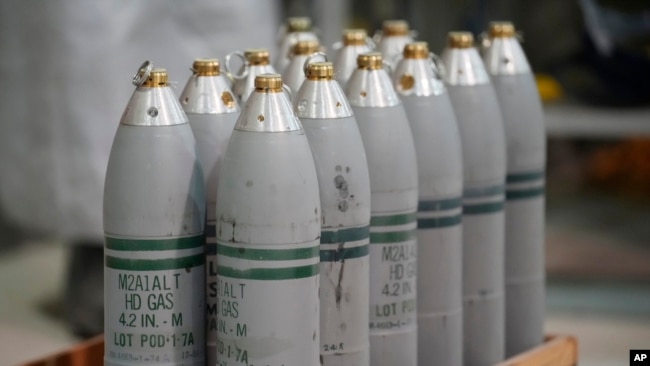US Destroys Last of Its Declared Chemical Weapons
Written by worldOneFm on July 8, 2023
RICHMOND, Ky. — The last of the United States’ declared chemical weapons stockpile was destroyed at a sprawling military installation in eastern Kentucky, the White House announced Friday, a milestone that closes a chapter of warfare dating back to World War I.
Workers at the Blue Grass Army Depot in Kentucky destroyed rockets filled with GB nerve agent, completing a decadeslong campaign to eliminate a stockpile that by the end of the Cold War totaled more than 30,000 tons.
“For more than 30 years, the United States has worked tirelessly to eliminate our chemical weapons stockpile,” President Joe Biden said in a statement released by the White House. “Today, I am proud to announce that the United States has safely destroyed the final munition in that stockpile — bringing us one step closer to a world free from the horrors of chemical weapons.”
The U.S. faced a Sept. 30 deadline to eliminate its remaining chemical weapons under the international Chemical Weapons Convention, which took effect in 1997 and was joined by 193 countries. The munitions being destroyed in Kentucky are the last of 51,000 M55 rockets with GB nerve agent — a deadly toxin also known as sarin — that have been stored at the depot since the 1940s.
By destroying the munitions, the U.S. is officially underscoring that these types of weapons are no longer acceptable in the battlefield and sending a message to the handful of countries that haven’t joined the agreement, military experts say.
Chemical weapons were first used in modern warfare in World War I, where they were estimated have killed at least 100,000. Despite their use being subsequently banned by the Geneva Convention, countries continued to stockpile the weapons until the treaty calling for their destruction.
In southern Colorado, workers at the Army Pueblo Chemical Depot started destroying the weapons in 2016, and on June 22 completed their mission of neutralizing an entire cache of about 2,600 tons of mustard blister agent. The projectiles and mortars comprised about 8.5% of the country’s original chemical weapons stockpile of 30,610 tons of agent.
Nearly 800,000 chemical munitions containing mustard agent were stored since the 1950s inside row after row of heavily guarded concrete and earthen bunkers that pock the landscape near a large swath of farmland east of Pueblo.
In the 1980s, the community around Kentucky’s Blue Grass Army Depot rose up in opposition to the Army’s initial plan to incinerate the plant’s 520 tons of chemical weapons, leading to a decadeslong battle over how they would be disposed of.
The military eliminated most of its existing stockpile by burning weapons at other, more remote sites such as Johnston Atoll in the Pacific Ocean or at a chemical depot in the middle of the Utah desert.
The Kentucky storage facility has housed mustard agent, VX and sarin nerve agents, much of it inside rockets and other projectiles, since the 1940s. The state’s disposal plant was completed in 2015 and began destroying weapons in 2019. It uses a process called neutralization to dilute the deadly agents so they can be safely disposed of.
Workers at the Pueblo site used heavy machinery to meticulously — and slowly — load aging weapons onto conveyor systems that fed into secure rooms where remote-controlled robots removed the weapons’ fuses and bursters before the mustard agent was neutralized with hot water and mixed with a caustic solution to prevent the reaction from reversing. The byproduct was further broken down in large tanks swimming with microbes, and the mortars and projectiles were decontaminated at 538 degrees Celsius and recycled as scrap metal.
Problematic munitions that were leaky or overpacked were sent to an armored, stainless steel detonation chamber to be destroyed at about 593 degrees Celsius.
The Colorado and Kentucky sites were the last among several, including Utah and the Johnston Atoll, where the nation’s chemical weapons had been stockpiled and destroyed. Other locations included facilities in Alabama, Arkansas and Oregon.
Officials say the elimination of the U.S. stockpile is a major step forward for the Chemical Weapons Convention. Only three countries — Egypt, North Korea and South Sudan — have not signed the treaty. A fourth, Israel, has signed but not ratified the treaty.
Concerns remain that some parties to the convention, particularly Russia and Syria, possess undeclared chemical weapons stockpiles. Biden on Friday urged Russia and Syria to fully comply with the treaty, and called on the remaining countries to join it.
AP








